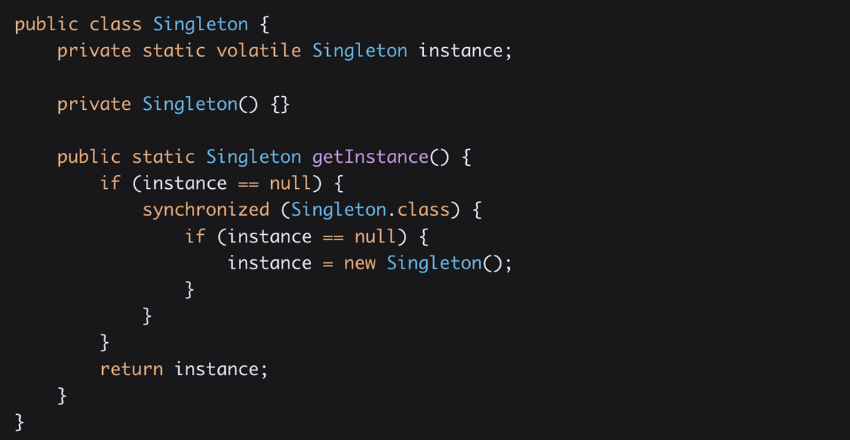The Singleton design pattern ensures that a class has only one instance and provides a global access point to this instance. This pattern is particularly useful when managing shared resources such as database connections, configuration settings, or logging mechanisms.
Key Concepts of Singleton Pattern
- Single Instance: Ensures that only one instance of the class is created.
- Global Access Point: Provides a way to access the instance from anywhere in the application.

Image source: Wikipedia-Singleton pattern
Benefits of Using the Singleton Pattern
Controlled Access to a Single Instance: The Singleton pattern ensures that a class has only one instance and provides a global point of access to it. This is useful for managing shared resources like configuration settings, logging, or database connections.
Resource Management: By ensuring only one instance of a class, the Singleton pattern helps in managing resources efficiently, avoiding the overhead of creating and destroying multiple instances.
Consistency: Since there is only one instance, it ensures that all parts of the application use the same instance, maintaining consistency across the application.
Implementation Steps
- Private Constructor: Prevents other objects from using the
newoperator to create new instances. - Static Method: Provides a global access point to the instance.
- Static Field: Holds the single instance of the class.
Example in Java
Here is a basic implementation of the Singleton pattern in Java:
public class Singleton {
// Static field to hold the single instance
private static Singleton instance;
// Private constructor to prevent instantiation
private Singleton() {
// Initialization code
}
// Public static method to provide access to the instance
public static synchronized Singleton getInstance() {
if (instance == null) {
instance = new Singleton();
}
return instance;
}
// Example method to demonstrate functionality
public void doSomething() {
System.out.println("Singleton instance is doing something!");
}
}Usage
public class Main {
public static void main(String[] args) {
// Access the Singleton instance
Singleton singleton = Singleton.getInstance();
singleton.doSomething();
}
}Lazy Initialization with Double-Checked Locking
For better performance in a multi-threaded environment, you can use double-checked locking:
public class Singleton {
private static volatile Singleton instance;
private Singleton() {
// Initialization code
}
public static Singleton getInstance() {
if (instance == null) {
synchronized (Singleton.class) {
if (instance == null) {
instance = new Singleton();
}
}
}
return instance;
}
public void doSomething() {
System.out.println("Singleton instance is doing something!");
}
}Early Initialization
In some cases, you might want to initialize the instance when the class is loaded:
public class Singleton {
private static final Singleton instance = new Singleton();
private Singleton() {
// Initialization code
}
public static Singleton getInstance() {
return instance;
}
public void doSomething() {
System.out.println("Singleton instance is doing something!");
}
}Ensuring Thread Safety in Singleton Pattern
Synchronized Method: Use a synchronized method to control access to the Singleton instance. This ensures that only one thread can execute this method at a time.
public class Singleton {
private static Singleton instance;
private Singleton() {}
public static synchronized Singleton getInstance() {
if (instance == null) {
instance = new Singleton();
}
return instance;
}
}Double-Checked Locking: This technique reduces the overhead of acquiring a lock by first checking the instance without synchronization.
public class Singleton {
private static volatile Singleton instance;
private Singleton() {}
public static Singleton getInstance() {
if (instance == null) {
synchronized (Singleton.class) {
if (instance == null) {
instance = new Singleton();
}
}
}
return instance;
}
}Bill Pugh Singleton Design: This approach uses a static inner helper class to ensure thread safety and lazy initialization.
public class Singleton {
private Singleton() {}
private static class SingletonHelper {
private static final Singleton INSTANCE = new Singleton();
}
public static Singleton getInstance() {
return SingletonHelper.INSTANCE;
}
}Real-World Examples of Singleton Pattern

Logger Classes: Singleton pattern is often used in logger classes to provide a global logging access point without creating multiple instances.
Configuration Classes: Used to manage configuration settings, ensuring that the settings are loaded once and reused.
Database Connections: Ensures that only one connection is used throughout the application, preventing resource conflicts.
Advantages and Disadvantages of Singleton Pattern

Advantages:
- Centralized access to a shared resource.
- Saves resources by preventing unnecessary object creation.
- Ensures consistent state throughout the application.
Disadvantages:
- Violates the Single Responsibility Principle by solving two problems at once.
- Can mask bad design by making components too dependent on each other.
- Requires special handling in multi-threaded environments.
What are some common pitfalls to avoid when implementing the Singleton pattern?
When implementing the Singleton pattern, there are several common pitfalls that developers should be aware of to avoid potential issues. Here are some of the most notable pitfalls:
1. Lack of Thread Safety
One of the most common mistakes is failing to ensure thread safety during the initialization of the Singleton instance. In a multi-threaded environment, this can lead to the creation of multiple instances.
Solution: Use synchronization mechanisms such as synchronized blocks or double-checked locking to ensure that only one instance is created even when multiple threads try to access it simultaneously.
public class Singleton {
private static volatile Singleton instance;
private Singleton() {}
public static Singleton getInstance() {
if (instance == null) {
synchronized (Singleton.class) {
if (instance == null) {
instance = new Singleton();
}
}
}
return instance;
}
}2. Eager Initialization
Creating the Singleton instance as soon as the class is loaded, rather than when it is first accessed, can lead to unnecessary resource consumption.
Solution: Use lazy initialization to create the instance only when it is needed.
public class Singleton {
private static Singleton instance;
private Singleton() {}
public static synchronized Singleton getInstance() {
if (instance == null) {
instance = new Singleton();
}
return instance;
}
}3. Tight Coupling
Singletons can introduce tight coupling between classes, making the code less modular and harder to test.
Solution: Consider using dependency injection to pass the Singleton instance to dependent classes, reducing tight coupling.
public class SomeClass {
private final Singleton singleton;
public SomeClass(Singleton singleton) {
this.singleton = singleton;
}
public void doSomething() {
singleton.doSomething();
}
}4. Global State
Using Singletons can introduce global state, making the codebase harder to reason about and debug.
Solution: Be cautious about what state the Singleton holds and ensure it is necessary for the Singleton to manage that state.
5. Testing Complexity
Singletons can make unit testing difficult because they introduce global state and tight coupling, which can lead to tests that are not isolated.
Solution: Use mocking frameworks to mock the Singleton instance or refactor the code to use dependency injection.
6. Serialization Issues
If the Singleton class implements Serializable, deserialization can create a new instance, breaking the Singleton pattern.
Solution: Implement the readResolve method to ensure that the deserialized instance is the same as the existing instance.
protected Object readResolve() {
return getInstance();
}7. Classloader Issues
In environments with multiple classloaders (e.g., application servers), each classloader may create its own instance of the Singleton.
Solution: Be aware of the classloader architecture and ensure that the Singleton is managed appropriately in such environments.
8. Overuse
Singletons are often overused, leading to poor design choices. Not every class that needs to be globally accessible should be a Singleton.
Solution: Carefully evaluate whether the Singleton pattern is the best fit for your use case. Consider alternatives like dependency injection or static classes.
Alternatives to the Singleton Pattern
Dependency Injection (DI): Instead of using a Singleton, you can use a DI framework to manage the lifecycle of your objects. This allows for more flexibility and easier testing.
Service Locator: This pattern provides a central registry where objects can be looked up. It can be used to achieve similar results as a Singleton without some of its drawbacks.
Static Classes: For utility functions that do not maintain state, static classes can be a simpler alternative to Singletons.
Best Practices for Testing Singleton Classes

Mocking: Use mocking frameworks to mock the Singleton instance. This allows you to isolate the class under test and avoid dependencies on the Singleton’s state.
Dependency Injection: Pass the Singleton instance as a dependency to the classes that need it. This makes it easier to replace the Singleton with a mock during testing.
public class SomeClass {
private final Singleton singleton;
public SomeClass(Singleton singleton) {
this.singleton = singleton;
}
public void doSomething() {
singleton.doSomething();
}
}Reset Method: In some cases, you might want to add a method to reset the Singleton instance for testing purposes. This should be used cautiously as it can lead to issues if used in production code.
public class Singleton {
private static Singleton instance;
private Singleton() {}
public static synchronized Singleton getInstance() {
if (instance == null) {
instance = new Singleton();
}
return instance;
}
// For testing purposes only
public static synchronized void resetInstance() {
instance = null;
}
}Test Order Independence: Ensure that your tests do not depend on the order in which they are run. This can be achieved by properly resetting the Singleton state between tests .
External Sources
https://stackoverflow.com/questions/137975/what-are-drawbacks-or-disadvantages-of-singleton-pattern











